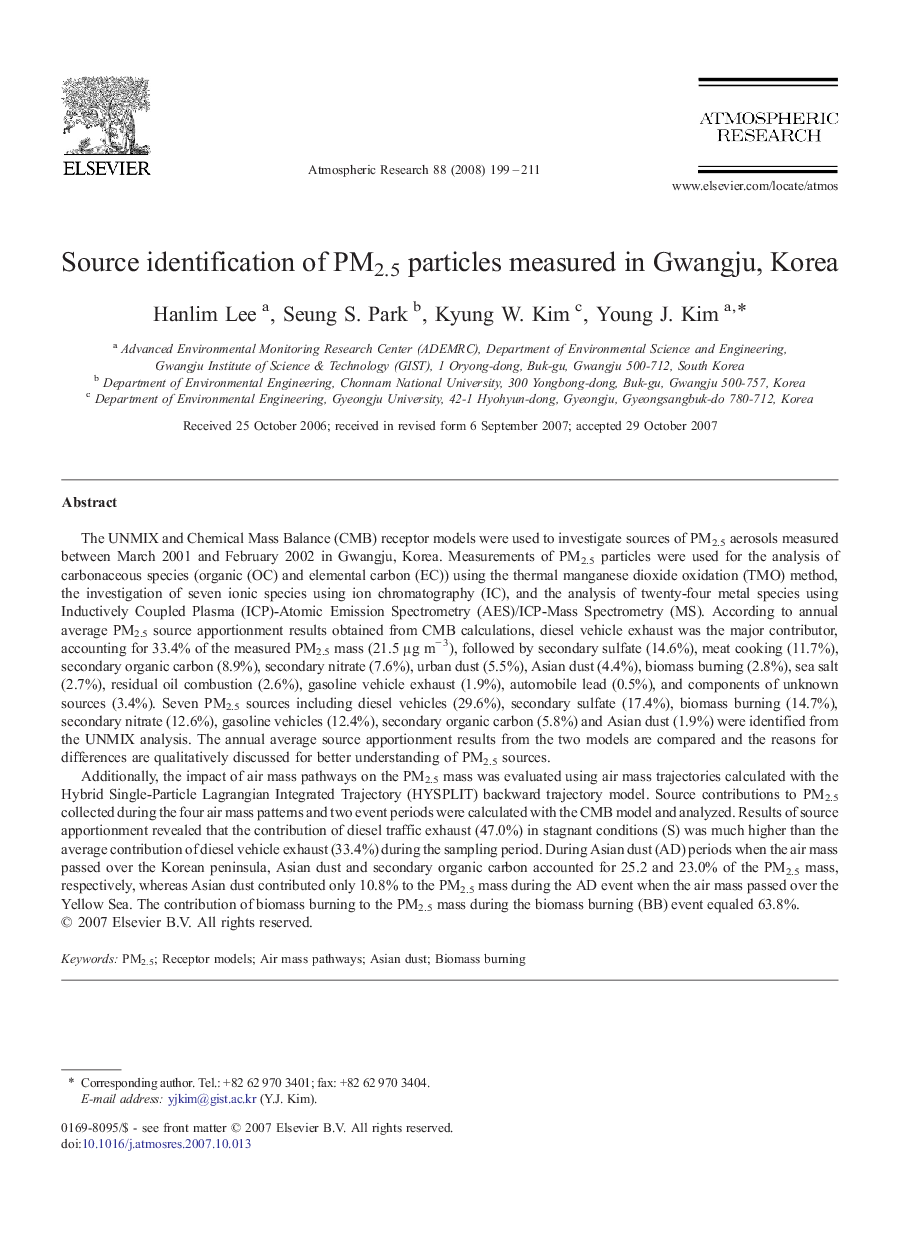| کد مقاله | کد نشریه | سال انتشار | مقاله انگلیسی | نسخه تمام متن |
|---|---|---|---|---|
| 4451127 | 1620573 | 2008 | 13 صفحه PDF | دانلود رایگان |

The UNMIX and Chemical Mass Balance (CMB) receptor models were used to investigate sources of PM2.5 aerosols measured between March 2001 and February 2002 in Gwangju, Korea. Measurements of PM2.5 particles were used for the analysis of carbonaceous species (organic (OC) and elemental carbon (EC)) using the thermal manganese dioxide oxidation (TMO) method, the investigation of seven ionic species using ion chromatography (IC), and the analysis of twenty-four metal species using Inductively Coupled Plasma (ICP)-Atomic Emission Spectrometry (AES)/ICP-Mass Spectrometry (MS). According to annual average PM2.5 source apportionment results obtained from CMB calculations, diesel vehicle exhaust was the major contributor, accounting for 33.4% of the measured PM2.5 mass (21.5 μg m− 3), followed by secondary sulfate (14.6%), meat cooking (11.7%), secondary organic carbon (8.9%), secondary nitrate (7.6%), urban dust (5.5%), Asian dust (4.4%), biomass burning (2.8%), sea salt (2.7%), residual oil combustion (2.6%), gasoline vehicle exhaust (1.9%), automobile lead (0.5%), and components of unknown sources (3.4%). Seven PM2.5 sources including diesel vehicles (29.6%), secondary sulfate (17.4%), biomass burning (14.7%), secondary nitrate (12.6%), gasoline vehicles (12.4%), secondary organic carbon (5.8%) and Asian dust (1.9%) were identified from the UNMIX analysis. The annual average source apportionment results from the two models are compared and the reasons for differences are qualitatively discussed for better understanding of PM2.5 sources.Additionally, the impact of air mass pathways on the PM2.5 mass was evaluated using air mass trajectories calculated with the Hybrid Single-Particle Lagrangian Integrated Trajectory (HYSPLIT) backward trajectory model. Source contributions to PM2.5 collected during the four air mass patterns and two event periods were calculated with the CMB model and analyzed. Results of source apportionment revealed that the contribution of diesel traffic exhaust (47.0%) in stagnant conditions (S) was much higher than the average contribution of diesel vehicle exhaust (33.4%) during the sampling period. During Asian dust (AD) periods when the air mass passed over the Korean peninsula, Asian dust and secondary organic carbon accounted for 25.2 and 23.0% of the PM2.5 mass, respectively, whereas Asian dust contributed only 10.8% to the PM2.5 mass during the AD event when the air mass passed over the Yellow Sea. The contribution of biomass burning to the PM2.5 mass during the biomass burning (BB) event equaled 63.8%.
Journal: Atmospheric Research - Volume 88, Issues 3–4, June 2008, Pages 199–211